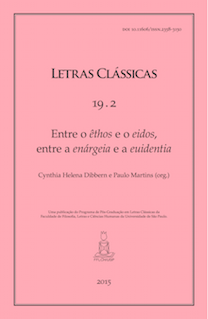Ritmo e expressividade do dístico elegíaco: Tibulo 1.3.1–4
DOI:
https://doi.org/10.11606/issn.2358-3150.v19i2p114-129Palavras-chave:
Ritmo poético, dístico elegíaco, escansão, Tibulo, semiologia, expressividadeResumo
A partir da consciência de que sílabas longas e breves (cor)respondem-se mutuamente num sistema de oposições básicas, é imprescindível verificar o papel desempenhado por elas nas cadeias fonossintáticas que formam os pés métricos, função que elas só desempenham através de valores psicológicos investidos nas estruturas hieraquicamente organizadas do verso, geradas a partir da oposição básica que elas encetaram. Tais valores são as propriedades combinatórias que os segmentos do nível seguinte permitem, quais sejam os metros e, em seguida, os pés métricos que eles realizam ou integram, daí o verso e, eventualmente, a estrofe, de modo a estruturar o poema todo. Tendo em vista que se trata sempre de concatenação de elementos, o conjunto formado tenderá a gerar uma orientação, isto é, um sentido, que é a princípio um determinado ritmo poético. O ritmo, entretanto, é influenciado por outras ocorrências ao longo da cadeia fonossintática, como as cesuras que incidem sobre a linha do verso. A partir da passagem de Tibulo, 1.3.1–4, o presente texto propõe levar em conta tais fatores para analisar o andamento rítmico-melódico da unidade estrófica formada pelo dístico elegíaco, com especial enfoque nas possibilidades de escansão geradas pela cesura-diérese fixa do pentâmetro e suas consequências para a expressividade poética.Downloads
Os dados de download ainda não estão disponíveis.
Downloads
Publicado
2015-12-10
Edição
Seção
Artigos
Licença
Autores que publicam nesta revista concordam com os seguintes termos:
- Autores mantém os direitos autorais e concedem à revista o direito de primeira publicação, com o trabalho licenciado simultaneamente sob uma Licença Creative Commons Attribution 2 anos após a publicação, permitindo o compartilhamento do trabalho com reconhecimento da autoria do trabalho e publicação inicial nesta revista.
- Autores têm autorização para assumir contratos adicionais separadamente, para distribuição não-exclusiva da versão do trabalho publicada nesta revista (ex.: publicar em repositório institucional ou como capítulo de livro), com reconhecimento de autoria e publicação inicial nesta revista.
- Autores têm permissão e são estimulados a publicar e distribuir seu trabalho online (ex.: em repositórios institucionais ou na sua página pessoal) a qualquer ponto antes ou durante o processo editorial, já que isso pode gerar alterações produtivas, bem como aumentar o impacto e a citação do trabalho publicado (Veja O Efeito do Acesso Livre).
Como Citar
Prado, J. B. T. (2015). Ritmo e expressividade do dístico elegíaco: Tibulo 1.3.1–4. Letras Clássicas, 19(2), 114-129. https://doi.org/10.11606/issn.2358-3150.v19i2p114-129


